Can French Bulldogs Swim? Tips for Keeping Your Frenchie Safe
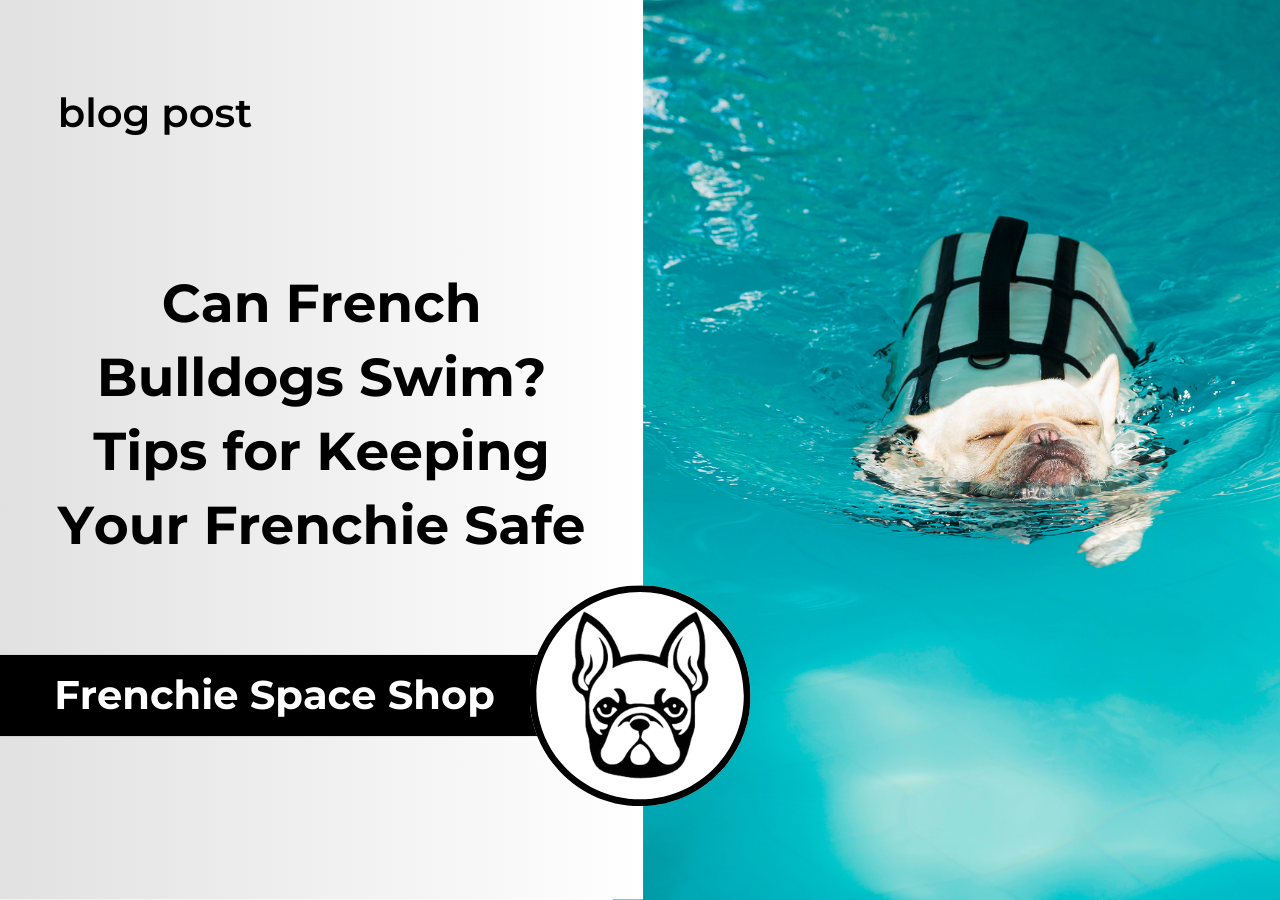
shaIf you’re a proud French Bulldog parent, you might have wondered: Can French Bulldogs swim? The short answer is no – at least not without help. These lovable little dogs may adore splashing in water, but they aren’t built to be natural swimmers. In fact, Frenchies (and bulldogs in general) have unique bodies and health traits that make swimming a real challenge.
Our blog post will answer the questions why French Bulldogs are not good swimmers, how you can help your Frenchie enjoy water safely, and why a doggy life vest is an absolute must. We’ll also share step-by-step tips so your Frenchie can cool off and have fun in the water without risking their safety.
Why French Bulldogs Aren’t Natural Swimmers
French Bulldogs are not built like typical swimming dogs. Unlike breeds such as Labradors or Poodles that glide through water with ease, Frenchies face an uphill battle the moment they step (or fall) into a pool. Here are the key reasons why French Bulldogs struggle to swim:
-
Top-Heavy Build and Short Legs
French Bulldogs have a stocky, muscular build with a large head and broad chest. This front-heavy body structure makes them prone to sinking. Their heads and front ends are big relative to their bodies, and they have thick muscles and heavy bones, which means they can’t keep themselves afloat easily. To make matters worse, their short legs don’t provide much paddling power. All that weight in the front and not enough “engine” in the back causes Frenchies to tire quickly and struggle to stay above water.
-
Flat Face and Breathing Difficulties
Unfortunately, that cute “smushed” snout is a big drawback in water. With such a short muzzle, a Frenchie has very little room to take in air when swimming. They often have to tilt their head way back just to keep their nose out of the water, which is awkward and tiring.
Plus, many Frenchies have Brachycephalic Airway Syndrome, causing snoring, wheezing, and low exercise tolerance. Put simply: it’s hard for a French Bulldog to breathe while swimming, and they can easily get winded or even inhale water. Breathing issues and water are a dangerous combo.
-
Limited Stamina and Overheating
Ever notice how your Frenchie prefers short play sessions and lots of naps? French Bulldogs, due to their build and breathing issues, don’t have the endurance of other breeds.
They can run and play, but only for so long before they need a break. Swimming is hard exercise – it would require even more stamina for a Frenchie to keep their head up and paddle effectively. On top of that, Frenchies are prone to overheating (one reason they love cool water!).
A hot, tired Frenchie in a pool is at high risk of drowning if they run out of energy. Their short-size, heavy-muscle body just isn’t designed for marathon workouts in the water.
-
Poor Buoyancy
Unlike leaner dogs, French Bulldogs have a high muscle-to-fat ratio. Muscle is denser than fat, so muscular dogs tend to sink rather than float. Your Frenchie is basically a little muscle-bound torpedo – great for cuddles, not so great for swimming.
Their compact, robust body and muscle density make it hard for them to float or stay buoyant in water. Frenchies lack the natural buoyancy that helps other dogs paddle around with ease.
French Bulldogs are not natural swimmers because of a perfect storm of body traits: a heavy front end, short airway, and limited endurance.
Even if you do see a rare video of a Frenchie doggy-paddling, they won’t be able to keep it up for long and could quickly run into trouble. Most Frenchies will sink like a stone if left unaided, so never assume your Frenchie can swim just because they love water.
Can French Bulldogs Swim Alone? Precautions Around Water
Before we even talk about teaching a Frenchie to swim, we have to stress water safety. If you have a pool, lake, or even a kiddie pool at home, you must take precautions so your French Bulldog doesn’t accidentally get in trouble. Here are a few golden rules:
Never Leave Your Frenchie Unattended Near Water
This one is non-negotiable. Supervision is a must whenever your Frenchie is near any body of water – whether it’s a deep pool or a shallow bathtub. Accidents can happen in seconds. Because Frenchies sink fast (even in surprisingly shallow water, you should always keep your eyes on them.) If your dog slips in or gets too excited and jumps, you need to be there immediately to help. Think of your Frenchie like a toddler around water – constant vigilance!
Use Barriers and Teach Pool Exits
If you have a swimming pool, consider using a pool fence or baby gates to prevent your Frenchie from wandering in. It’s also wise to teach your French Bulldog how to find the pool steps or ramp. In an emergency, knowing how to get out could save their life. Practice guiding your Frenchie to the pool’s exit over and over (with treats and praise) so it becomes second nature. Still, no Frenchie should ever have unsupervised pool access, even if they seem confident.
Avoid Strong Currents or Deep Water
Frenchies should stay in shallow, calm water. Beach waves, rivers with currents, or deep lakes are too risky. A strong current or wave can easily knock a French Bulldog off balance or pull them under since they can’t swim strongly against it. Stick to kiddie pools, the shallow end of a pool, or very gentle shorelines for cooling off. Always err on the side of caution – if it looks at all challenging, keep your pup out of it.
Mind the Weather
Because Frenchies overheat, you might be tempted to let them swim to cool down. That’s fine in a controlled setting, but be careful on very hot or humid days. Heat can tire them out faster (and if the water itself is too warm, it won’t help much). On the flip side, cold water or cold weather can shock a small dog’s system. Try to choose mild, pleasant weather for any swimming sessions, and always have fresh drinking water nearby (especially if you’re at the beach – you don’t want your pup gulping salty sea water, which can cause dehydration and sickness.
How to Help a French Bulldog Swim Safely (Step-by-Step)
So you want to let your Frenchie join you in the pool or at the lake? Great – but do it safely. Follow these step-by-step tips to give your French Bulldog a safe “swimming” experience. Remember, the goal isn’t to turn your Frenchie into an Olympic swimmer (that’s not going to happen!), but to let them cool off and paddle a bit without danger.
1. Gear Up with a Canine Life Vest
The first step for any Frenchie in water: put a life jacket on them. Always. A quality dog life vest designed for French Bulldogs is non-negotiable for safety. These vests provide vital buoyancy to keep your pup’s head above water, essentially doing the floating that your Frenchie’s body can’t do on its own. In fact, responsible owners of Frenchies always use life vests to help their dogs stay afloat. When choosing a life jacket for a Frenchie, look for:
- Proper Fit: It should be snug but comfortable. Many Frenchie-specific life vests have adjustable straps to fit their stout body. A vest that’s too loose could slip off in the water, and one that’s too tight will be uncomfortable. Breed-specific designs are great because they account for the Frenchie’s neck and chest girth.
- Ample Buoyancy: Good vests have flotation panels under the belly, on the back, and sometimes around the neck. This helps keep your Frenchie level in the water instead of nose-diving.
- Handles and High-Visibility: Ideally, the vest has a sturdy top handle. That way, you can grab the handle to lift your Frenchie out of the water quickly if needed (a crucial feature for a breed that can start sinking fast). Bright colors or reflective strips are a plus, making your dog easy to spot in the water.
Before you ever hit the pool, let your Frenchie get used to the life jacket at home. Put it on them for a few minutes, give treats or play, so they associate it with good things. This way, they won’t panic or feel weird when it’s vest time. Never let your Frenchie near open water without their life jacket on – it’s truly a lifesaver.
2. Start in Shallow Water (Kiddie Pool Fun)
When introducing your French Bulldog to water, think baby steps. Do NOT toss your Frenchie into a deep pool expecting them to doggy paddle – that’s dangerous and terrifying for the dog. Instead, start with very shallow water. A popular approach is using a kiddie pool in your backyard.
Just fill a plastic kiddie pool with a few inches of water (no higher than your Frenchie’s chest). This lets your pup splash and sit in the water without needing to swim at all.
Many Frenchies will happily stomp around and play in a shallow pool since they can feel the bottom and keep their nose easily in the air. It’s a perfect, low-risk introduction.
If you don’t have a kiddie pool, try the shallow edge of a pond or lake, or the steps of a swimming pool. Keep the water level low enough that your Frenchie’s chin stays above water when standing.
The idea is to get them used to the sensation of water around them without the panic of floating. Praise them and stay right by their side. You can even get in the water with them (at their level) to show them it’s safe.
As your Frenchie gets comfortable splashing in shallow water, they’ll build confidence. Some Frenchies will paw and play; others might be a bit unsure – that’s okay. Take it at their pace. The goal is no fear of the water.
3. Use Positive Reinforcement
French Bulldogs are people pleasers and many are highly motivated by treats and praise. Leverage that! Make any water time a happy, positive experience. When your Frenchie steps into the water or stays calm in their kiddie pool, reward them. Use a cheerful voice – “Good boy/girl!” – and maybe offer a small treat or favorite toy. This positive reinforcement creates a good association with water.
Never yell or punish your Frenchie for being hesitant in water. If they sense your frustration, they’ll hate water even more. Instead, encourage and reassure. You can even get in the shallow water and play to show them there’s nothing to fear.
Some owners bring a waterproof toy to get the dog’s mind on fun rather than the new sensation of water. The key is to make sure your Frenchie feels safe and praised every step of the way. Over time, with gentle encouragement, they may become more eager to get those paws wet.
4. Gradually Increase Water Depth (Slow and Steady)
Once your Frenchie is enjoying the kiddie pool or the shallow step, you can very slowly increase the challenge – but caution is key here. If you’re in a pool, go one step deeper so your dog has to paddle just a little before touching the ground. If you’re in a lake or kiddie pool, add a tiny bit more water. Always keep the life jacket on and stay right next to them.
Watch your Frenchie’s body language closely. If they seem relaxed and are paddling calmly for a moment or two, great! If they start to panic, guide them back to where they can stand. Never force them to go deeper than they’re ready for. Some Frenchies might only ever feel comfortable in chest-deep water, and that’s totally fine.
You might find that with each short session, your dog gets a bit more accustomed to floating. Take your time – this could be over several days or weeks of short practice sessions. Short sessions are better than one long one. Maybe do 5-10 minutes of water play, then take a break.
As you increase depth, keep talking to your pup in a calm, happy tone. You’re effectively acting as their swim coach and lifeguard.
Stay within arm’s reach at all times. In fact, one expert tip is to use a “buddy system” – actually swim alongside your dog, supporting their belly if needed. By being right there in the water, you can help them stay afloat and guide their movements. It also reassures your Frenchie that you’re in it together!
5. Stay by Their Side & Support Them
Even if your Frenchie starts paddling a bit on their own, don’t let go of supervision or physical support. Many French Bulldogs will never be able to truly swim independently, even with a vest – and that’s okay.
Think of your role as holding a toddler who’s learning to swim. You might keep a hand under their belly or just be ready to grab them if their head dips. Using the life vest’s handle can give you a good grip when needed. If you venture into water where your Frenchie can’t touch the bottom at all (which should only happen once they’re quite confident in shallow water), consider gently holding them up to guide their paddling. This helps them learn the motion without the full struggle of keeping afloat alone.
Always be ready to scoop your Frenchie up at the first sign of fatigue or distress. If you notice them breathing hard, pawing frantically, or if they look panicked, immediately bring them to shallow water or dry land to rest. Never take your eyes off them the entire time they’re in water – even for a moment to reach for a towel. Constant vigilance is crucial.
6. Keep Sessions Short and Watch for Tiredness
Frenchies can get tired very quickly in water. A few minutes of paddling can be as exhausting for them as a long run would be for a more athletic dog. Limit any swim practice to a few minutes at a time, especially early on.
Take frequent breaks. It’s better to do multiple short sessions (with rest in between) than one long session where your pup might suddenly run out of energy in the middle of the pool.
Watch your Frenchie’s breathing and overall demeanor. If you see excessive panting, coughing, or if they seem to be slowing down, it’s time to call it a day. End on a positive note – maybe with one last successful shallow splash – then wrap them in a towel, give praise and let them relax.
Remember, swimming (even assisted swimming) is a heavy workout for a French Bulldog. It’s supposed to be fun, not overly taxing. Know your dog’s limits and stick to them. Never push for too long.
7. Rinse Off and Warm Up After
After any swim or dip, make sure to rinse your Frenchie with fresh water (if in a chlorinated pool or saltwater) to get chemicals or salt off their fur and skin. Dry them off with a towel, especially in their face wrinkles and ears, to prevent irritation. Lots of Frenchies also appreciate a post-swim snuggle in a warm towel since they can get chilled easily once out of the water.
By following these steps, you’re not exactly teaching your French Bulldog to swim laps, but you are teaching them to be comfortable and safe in and around water. The goal is to let them enjoy the benefits of cooling off and playing without the drowning risk. Some Frenchies might only ever wade or float with assistance, and that’s perfectly fine! Every dog is different – the important thing is safety and fun.
Life Jackets: A Must-Have for Frenchies in Water
Let’s talk more about those doggy life jackets, because they truly are the unsung heroes of Frenchie water play. Why are life vests so important for French Bulldogs? Simply put, a life jacket can save your Frenchie’s life. Without one, a Frenchie in deeper water is almost guaranteed to sink at some point due to the reasons we discussed (heavy body, poor breathing, etc.). A life vest buoys them up, giving your pup a fighting chance to paddle and keeping their nose above water. Even in shallow water, a vest adds an extra layer of safety.
Here are a few key points on the importance of life vests and tips on using them:
Buoyancy and Confidence
The BlueSea French Bulldog Life Jacket will keep your Frenchie afloat even when they stop paddling. This not only prevents drowning, but also gives the dog confidence. Many Frenchies who panic in water feel a lot calmer once they float a bit.
This Frenchie life vest does a lot of the work, so your dog can just enjoy the sensation of swimming instead of struggling. One Frenchie owner noted that with a life jacket, their dog could spend more time in the water without getting tired so quickly.
Special Designs for French Bulldogs
Not all dog life jackets are the same. French Bulldogs have unique shapes (barrel chests, short bodies), so a vest designed for bulldog breeds is ideal. The Nemo French Bulldog Life Jacket has extra flotation under the neck/chin area to help keep the head above water, and wide straps for that broad chest.
The Frenchie’s “wide load” body needs support, so investing in a well-made vest is worth it. Ensure it’s rated for your dog’s weight.
Handles for Rescue
As mentioned earlier, choose a vest with a strong top handle. The Reflective French Bulldog Life Vest is one of those that will be of great help while swimming in open waters.
In an emergency, being able to grab that handle and hoist your Frenchie out can make all the difference. Imagine your Frenchie jumps into a pool – with a handle, you can fish them out immediately.
Without it, you’re scrambling to grab a slippery, sinking dog. Many canine life vests also have a D-ring for a leash, which is handy if you’re at a public beach and want to keep them from venturing too far.
Always Put the Vest on Before Approaching Water
Don’t wait until your dog is already in the water to secure their vest. Put it on before they even go outside near a pool or lake. That way there’s no chance they’ll run in unprotected. Make it a rule: no vest, no water play. Check our SharkyMermaid Frenchie Life Jacket because it will give your the essential safety.
Frenchies can be sneaky and love water, so if they see a body of water they might try to jump in out of excitement. Having the vest on turns a potential disaster into a manageable situation.
Life Vest is Not a License to Leave Them Unwatched
One caution – just because your Frenchie is wearing a life jacket doesn’t mean you can relax your supervision. Still watch them like a hawk. The Splashy Frenchie Life Jacket greatly reduces drowning risk, but things can still go wrong (the vest could slip, the dog could tip over, etc.).
Think of the life jacket as your safety backup, not a free pass to let your dog swim alone. Even with a vest, Frenchies should never swim unsupervised.
Conclusion: Enjoy Water Safely With Your French Bulldog
So, can French Bulldogs swim? Technically, most Frenchies can’t swim on their own – their little bodies just aren’t made for it. But with the right precautions, they can still enjoy the water in their own way.
Every French Bulldog is different. Some might surprise you with a (supervised) doggy paddle, while others will prefer to just lounge in the shade. Both are okay! The goal is not to force your Frenchie to swim, but to make sure that if they do go near water, they are protected and comfortable.
READ ALSO:

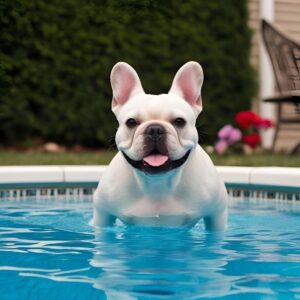
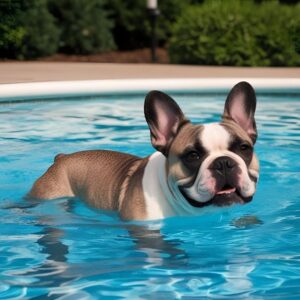

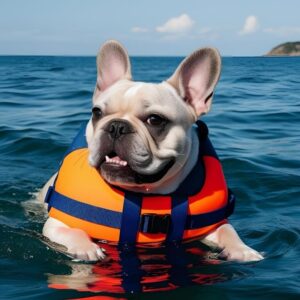
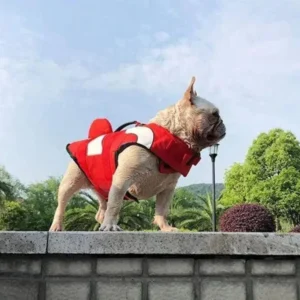
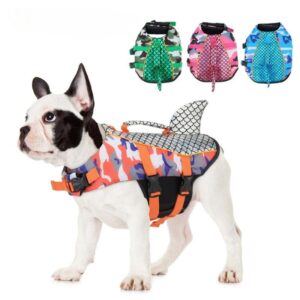



 French Bulldog Jackets & Coats
French Bulldog Jackets & Coats French Bulldog Dresses & Skirts
French Bulldog Dresses & Skirts French Bulldog Hoodies
French Bulldog Hoodies French Bulldog Sweaters
French Bulldog Sweaters French Bulldog Shirts
French Bulldog Shirts French Bulldog Pajamas
French Bulldog Pajamas French Bulldog Costumes
French Bulldog Costumes French Bulldog Life Jackets
French Bulldog Life Jackets

 French Bulldog Collars
French Bulldog Collars French Bulldog Harness
French Bulldog Harness
 French Bulldog Backpacks
French Bulldog Backpacks







